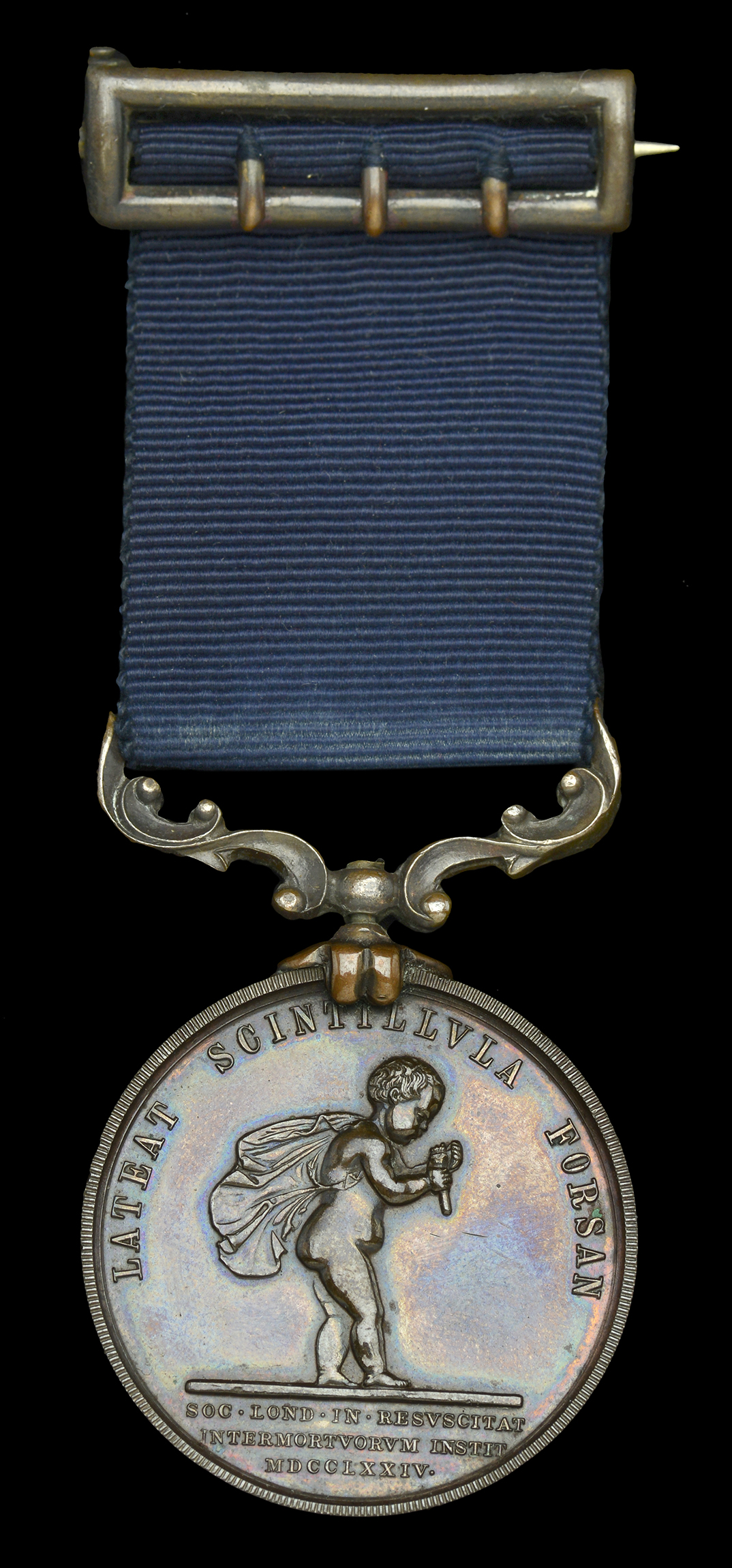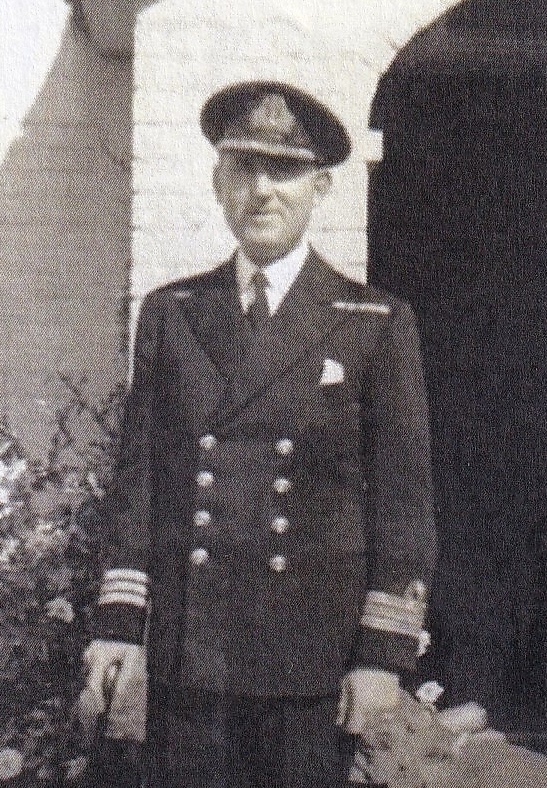‘A few hours after the declaration of war a division of British destroyers slid out of Harwich and began a thorough search of the lower end of the North Sea ... they had hardly been under way an hour before the leading destroyers sighted was at first appeared to be a steamer belonging to the Great Eastern Railway making slowly towards the Dutch coast [it was in fact the Königin Luise, a carefully disguised German minelayer]. A warning shot calling upon the vessel to stop was ignored - it was the first shot of the war - and immediately after a deliberate and well-aimed fire was opened. Shortly after twelve o’clock - just three hours after our vessels left port - she disappeared beneath the waters of the North Sea. Fifty seven of her crew were rescued’. ‘The attack on the German Mine-Layer Königin Luise, from Deeds that Thrill the Empire’ The historically important Royal Humane Society Medal awarded to Sub-Lieutenant C. D. Bury, H.M.S. Landrail, Royal Navy, for saving the life of a German officer from drowning on the occasion of the sinking of the German Minelayer Königin Luise on 5 August 1914; with the Great War barely hours old, this was the first recognised act of gallantry of the entire War. Bury subsequently served in H.M.S. Landrail at the Battle of Jutland; took part in the Zeebrugge Raid; and for his services during the Great War was three times Mentioned in Despatches Royal Humane Society, small silver medal (successful) (Sub. Lt. Claude D. Bury R.N. 5th Aug. 1914.) with integral top bronze riband buckle, edge nicks, good very fine £700-£900 --- R.H.S. Case no. 41,158: ‘On the 5th August 1914, shortly after the German mine layer Königin Luise had been sunk in the North Sea a German officer was seen in the water in an exhausted state. Sub-Lieutenant Claude Bury, H.M.S. Landrail, and Gunner E. G. Haycroft plunged overboard and kept him afloat till they were picked up.’ Claude Denzil Bury was born in Kensington, London, on 27 April 1893, and joined the Royal Navy as a Naval Cadet on 15 January 1906. Appointed Midshipman on 15 May 1911, he was commissioned Acting Sub-Lieutenant on 15 September 1913, and was posted to the torpedo boat destroyer H.M.S. Landrail in June 1914. Britain declared War on Germany at 11:00 p.m. on 4 August 1914. Early the following morning, 5 August, H.M.S. Landrail, as part of the 3rd Flotilla led by H.M.S. Amphion, and accompanied by H.M.S. Lance, sortied into the North Sea to patrol the area between Harwich and the Dutch island of Terschelling for German activity. At 10:15 a ship in the black, buff, and yellow colours of the Great Eastern Railway’s steamers that plied between Harwich and the Hook of Holland was spotted, ‘throwing things overboard, presumably mines’. H.M.S. Amphion led the flotilla to investigate and observed that the fleeing ship was deploying mines even then. At 10:45, Lance opened fire at a range of 4,400 yards. The target was S.M.S. Königin Luise, a former Hamburg-Heligoland excursion boat that had been converted to an auxiliary minelayer by the Germans. They had planned to mount a pair of 8.8-centimetre (3.5 in) guns on board, but they did not have the time to do so; her only armament was a pair of lighter guns and 180 mines. During the night she had departed Emden and headed into the North Sea to lay mines off the Thames Estuary, which she began to do at dawn. The fire from the destroyers was ineffective until Amphion closed to a range of 7,000 yards and began hitting the German ship at about 11:15. By noon, Königin Luise was sinking and her Captain, Commander Biermann, ordered the vessel to be abandoned; as the men jumped into the water, many struggled to stay afloat in the choppy waters. Witnessing the struggles of the German sailors in the water, Bury and a gunner, Ernest Haycroft, jumped into the water and held the grievously injured Biermann aloft. A rope was thrown, and the three men were hauled aboard the Landrail, where mobilisation papers were found upon the injured German captain. In all the three British ships rescued 5 enemy officers and 70 ratings. As a result of their gallantry, both Bury and Haycroft were recommended by the Admiralty to the Royal Humane Society: ‘I am Commanded by my Lords Commissioners of the Admiralty to request you will express their satisfaction to Sub-Lieutenant Claude D. Bury and Mr. Ernest G. Haycroft, Gunner of H.M.S. Landrail, for their meritorious conduct in saving the life of a German Officer from drowning on the occasion of the sinking of the German Minelayer Königin Luise on 5 August. My Lords are prepared to recommend these two Officers to the Royal Humane Society.’ Returning to port early on the morning of 6 August, after 24 hours on patrol, H.M.S. Amphion struck one of the mine’s that had been laid by the Königin Luise and sank, with the loss of one officer and 131 ratings killed, together with an unknown number of German prisoners of war rescued from Königin Luise. She was the first ship of the Royal Navy to be sunk in the Great War. Two days later, Captain Biermann succumbed to his injuries. Bury returned safely to port in H.M.S. Landrail, and remaining in her, was promoted Lieutenant on 15 May 1916, being present at the Battle of Jutland on 31 May 1916. Noted as ‘an exceptionally capable officer’, he was three times Mentioned in Despatches (London Gazettes 14 September 1917; 23 July 1918; and 20 February 1919), including for distinguished services during the Zeebrugge raid on 23 April 1918, and later served in the Middle East. Advanced Lieutenant-Commander on 15 May 1924, he retired in the rank of Commander, and died in Winchester on 17 March 1957 at the age of 64. Sold with the named Bestowal Document for the Royal Humane Society Medal, in original transmission tube, together with a fair copy of the original Admiralty recommendation; the recipients related miniature awards (comprising a 1914-15 Star trip with M.I.D. oak leaves in addition to the Royal Humane Society Medal); a bronze Royal Life Saving Society Proficiency Medal, the reverse engraved ‘C. D. Bury. Feb. 1910’, in embossed case photographic image of the recipient; and copied research.









